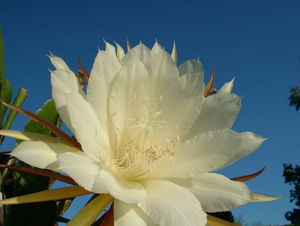A neighbor once brought me a piece of some type of cactus that she had found while vacationing in Florida. I left the cactus in the paper bag and, quite frankly, forgot about it. In fact, the bag with the cactus in it sat in a corner of my front porch for two years through all types of weather. I finally looked in the bag, discovered that the cactus still looked pretty good, and decided to stick it in some dirt. Believe it or not, the cactus took root and started to grow … and grow … and grow. It grew to the point that I had to put it in a monstrous pot and use a hand truck to move it. At the time, no one knew what it was called. Due to its outrageous growth, we started calling it the “kudzu cactus.” Then, after about five years, it bloomed. That is when I realized that I had an orchid cactus.
The orchid cactus (Epiphyllum) actually belongs to a group of hybrids created from true epiphyllums and other jungle cacti. This cactus gets its name from the blooms it produces. It usually blooms in the spring; although, different varieties bloom more than once, while other’s will bloom off-and-on all year long. The cup-shaped blooms can be six inches across or larger and can be found in every color except blue.
My orchid cactus was one of the two most popular varieties grown as a houseplant. Known as ‘Cooperi,’ mine was one of the white-flowered orchid cacti, distinguished by large white flowers that would form on areoles near the base of the stem. (The flowers on other varieties form at areoles near the tip of the stem.) Another unique aspect of white-flowered varieties is their tendency to bloom at night. (Mine would start blooming late in the afternoon and continued until the next morning.) Also, these varieties are quite fragrant and have a scent very similar to lilies.
The second most popular orchid cactus is called ‘Ackermannii.’ This variety produces brilliant red blooms that are 4-6 inches in size. It also a very prolific bloomer, blooming not only in the spring and summer but also in the fall and winter.
The stems of the orchid cactus are flat and notched, 2-feet or more in length, and at least 2 inches wide. They tend to hang down over the sides of the pot; however, you can stake them if you prefer a more upright growth. An interesting side note: One of the stalks on my orchid cactus had somehow gotten broken about halfway down the stalk. It was not completely severed, however. I pulled the hanging piece of stem back into place and wrapped apiece of aluminum foil around the lesion. Within about two weeks, the break and completely healed, leaving the stem whole once more.
Orchid cacti like medium light [see Houseplants: Determining Light Levels in Your House] and need a shady spot when placed outside. They thrive on warm temperatures and high humidity. [See: Houseplants: Increasing the Humidity.] Keep the soil evenly moist during the flowering period and then allow it to dry out between waterings after the flowering period. Once the flower buds begin to appear, apply a tomato-type fertilizer every two weeks until the flowers open, at which time you should stop fertilizing. When planting, use an African violet potting mix. [See: Making Your Own Potting Mixes for Your Houseplants.] Re-pot whenever necessary. Propagate from stem cuttings.
I am not guaranteeing that your orchid cactus will behave like mine and turn into a monster. If you, however, want a plant that will produce gorgeous blooms and is easy to grow, then the orchid cactus is for you. (Any doubts about the easy-care quality of this plant? Perhaps you should re-read the first paragraph of this article.)
References:
Huxley, Anthony, ed. Success with House Plants. Pleasantville, NY: The Reader’s Digest Association, Inc., 1979.
DeWolf, Jr., Gordon P., ed. Taylor’s Guide to Houseplants. Boston, MA: Houghton Mifflin Company, 1987.






